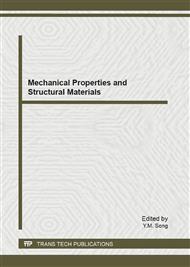p.532
p.535
p.539
p.544
p.548
p.552
p.556
p.560
p.564
Preparation and Properties of the Underwater Curing Epoxy Adhesives*
Abstract:
The epoxy adhesive is prepared according to the optimal formula of the orthogonal experiment, and its curing properties, the dynamic mechanic parameters, Fourier transform infrared spectrometer(FTIR) and the thermogravimetric analysis(TGA) are measured. And its shear adhesive strength is about 22.0MPa, its tensile strength is about 12.50MPa and its charpy impact strength is 9.41kJ/m2. The result of TGA and dynamic mechanic analysis(DMA) test have shown that the thermal stability of the epoxy adhesive is good before 335°C and its weight retention ratio is more than 90% and Tg≈50°C. By exploring the experiments, the tensile adhesive strength of the dumbbell sample in the concrete for the underwater curing epoxy adhesives is more than 2.26~2.98MPa. Epoxy resins have many excellent properties of mechanics and adhesion. By suitable modification of the epoxy resins, they have widely been applied for the leakage proofing in the underground and the submarine tunnel; the repairing and reinforcing of the dikes, dams and bridges; the repairing of the mechanical, electrical and chemical equipments[1]. Since1960’s, the underwater curing epoxy adhesives are developed and a great many works are done[2-10], for example, α-cyanoacrylate adhesive, the organosilicone adhesive, the urethane adhesive. But the open literatures abroad are few[11]. Zhang et al[12] investigated systematically the viscosity, reavtivity, mechanic and adhesive properties of the underwater curing epoxy adhesives for different curing agent systems, However, these studies concentrate on the laboratory results on the sheet steel piece, and the experimental testes on the damp and underwater concrete samples have not been seen up to now. This paper tried to explore the experiments on the damp and underwater concrete samples and obtained some good results based on the laboratory development on the sheet steel pieces.
Info:
Periodical:
Pages:
564-568
Citation:
Online since:
October 2012
Authors:
Price:
Сopyright:
© 2012 Trans Tech Publications Ltd. All Rights Reserved
Share:
Citation:


